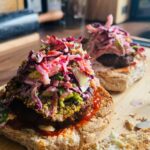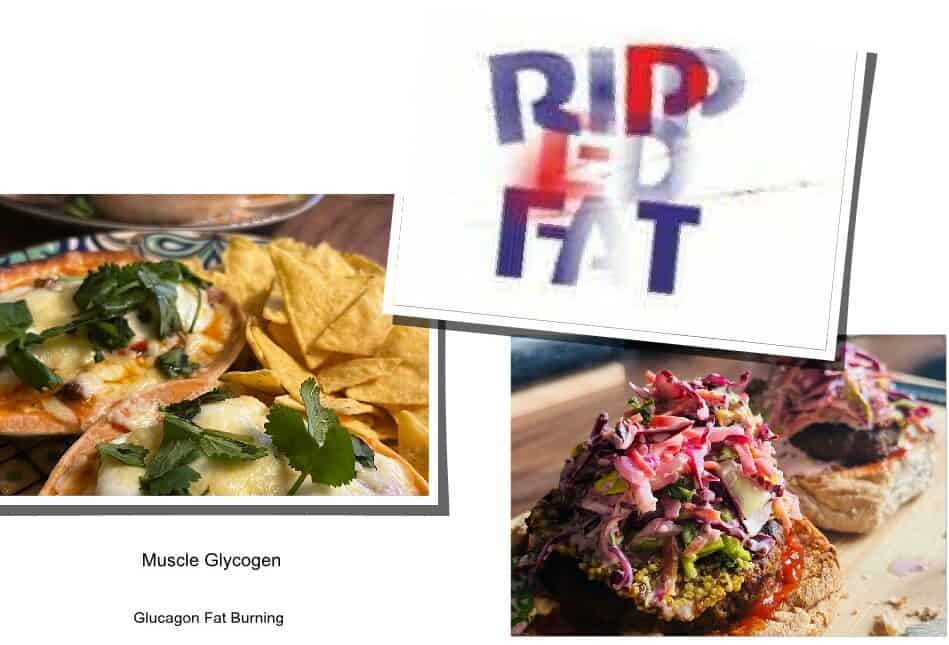RIPPEDFAT

Glucagon For Weight Loss,
Pro Fat Burning
Muscle Up
Glucagon for weight loss, glycogen, and insulin play crucial roles in energy storage and muscle growth. Glycogen, a form of carbohydrate, is stored in muscle and the liver, if not used immediately as energy will be converted into fat when excess glucose enters the bloodstream. Insulin aids in the uptake of glucose into muscle cells, which is vital for muscle growth, while glucagon ensures glucose is available for energy production. Excessive insulin in the bloodstream can lead to glucose being stored as fat, which inhibits glucagon production. Glycogen serves as the primary energy source during prolonged, intense exercise; without it stored in skeletal muscles, one cannot perform optimally during workouts, hindering muscle growth.
Insulin and glucagon are crucial hormones for metabolism and muscle growth. Insulin, produced by the pancreas, regulates carbohydrate metabolism, while glucagon acts as a fat-burning hormone, doing the opposite by raising glucose levels through the breakdown of glycogen in the liver and muscle cells. Excessive glucose in the bloodstream can trigger a negative metabolic response, leading to the automatic storage of sugar and fat as body fat. Once these fat stores are established, reaching your metabolism’s set point becomes difficult, as insulin primarily promotes fat storage and inhibits fat burning and weight loss.
Say No To Apple Shape Belly Fat
Say Yes To Pear Shape
Pro Ripped Fat Burner
Dont Just Think Weight Loss Think Hormones
Glucagon Glycogen Insulin

Glucagon And Insulin
Both Promote Fat Storage
Glycogen Provides The Body With
A Ready Available Source Of Energy
Pro Ripped Fat Burner
Glucagon For Weight Loss
A Pro Max Level To
Fat Burning
Consuming foods that boost metabolism allows for optimizing your metabolic rate without resorting to starvation. Metabolism encompasses the processes of breaking down food to release energy and synthesizing the compounds required by cells. The nutrients in our diet play a crucial role in accelerating metabolism which activates the fat-burning hormone glucagon, aiding in weight loss and supporting the metabolic activities that produce energy, as well as the creation of new proteins and nucleic acids, such as DNA. Glucagon is not directly involved in fat loss; rather, it is a mechanism that releases stored fat. Once insulin levels are depleted, this hormone can convert stored fat cells into glucose to be used as fuel. This process engages the glycogen hormone, which is crucial for muscle growth.
When you consume carbohydrate foods your blood sugar levels rise your body responds to insulin. When glucose levels are elevated insulin will rise to keep more energy in storage this has a negative effect on weight loss your metabolism is not burning calories, glucose entering the bloodstream is going straight to fat cells as stored fat.
It is not just about a quicker rate metabolism alone will your body burn calories you need to build up a calorie deficit and less about how drastically trying to change how your body’s metabolism works.
This deficit can be achieved for sustainable weight loss of eating vegetables lean protein fiber low carbohydrate foods combined with regular activity or fitness work outs. To achieve a professional level to fat burning requires getting your body into a pro ripped fat burner response this means don’t just think about losing the calories also think about the hormones that interact in this process. Fat the burning requires a delicate balance between the rise and fall of blood sugar (glucose) and insulin that also interchanges with the glycogen and glucagon hormone. Excessive glucose in the bloodstream triggers a negative metabolic response to insulin, leading to the automatic storage of sugar and fat as body fat. Once these fat stores are established, it becomes challenging to reach your metabolism’s set point, as insulin is the primary regulator that promotes fat storage and stops the fat burning hormone to produce glucagon for weight loss.
Glucose metabolism is insulin-dependent consuming high-sugar carbohydrates raises glucose levels in the bloodstream, which stimulates insulin release. This promotes energy storage in fat cells, leading to an overweight, apple-shaped belly in men and an oversized, pear-shaped body around the tummy, hips, and thighs in women. Unless glucagon for weight loss is activated, glucose will become stored body fat, converted into glycogen, it must be used immediately for energy during workouts and muscle growth and definition during a weight loss strategy.
Tapping In
Glucagon For Weight Loss
If you don’t expend energy throughout the day, avoid workout exercises, and continuously consume high-sugar carbohydrates, you will gain weight. To prevent this, your body must reach a metabolic rate akin to that of a professional athlete. This involves cutting back on refined and processed foods such as cornflakes, white toast, pasta, rice, pastries, sweet biscuits, and certain fruits. Reducing sugar intake is crucial because it often leads to fat and carbohydrate accumulation, as well as in sugary beverages like sodas and juice drinks. To tap into the body’s fat reserves, you need to focus on eating hard-core power foods to help deplete glycogen, which is stored as fat, sugar triggers insulin production. Once glycogen stores are fully depleted, the fat-burning hormone glucagon can effectively work, allowing the body to metabolize fat as its primary energy source instead of sugar.
Glycogen is great for body building and muscle growth during and after work outs but not for losing weight.
Tapping in utilizing fat reserves as an energy source is healthier and more efficient than relying primarily on sugar. This process, which involves a higher metabolism and the use of glucagon for weight loss, plays a crucial role in shaping the body by burning fat instead of carbohydrates (sugars). By consuming core power-food rich in protein and fat, you can activate the fat-burning hormone, leading to fat loss and muscle definition, as muscle and fat behave differently in the body.
Muscle Up On hard Core Power Foods
Muscle is significantly more metabolically active, requiring many more calories to maintain than an equal amount of fat. Unlike carbohydrates, which are absorbed quickly, fats undergo a process that consumes a lot of energy to burn. focus on core-power-foods will not only provides more energy for burning but also promotes a feeling of fullness and satisfaction for an extended period.
Glucose levels from carbohydrate (calories) foods entered into the bloodstream is influenced by the food consumed and their quantity, which is crucial for maintaining stable blood sugar levels.
The foundation of diet is combining carbohydrate foods with a low glycaemic index alongside proteins and fats, in reaction to the insulin hormone and glycogen storage, a hormone that influences glycogen. Glycogen, which is essentially stored energy, can slow down the metabolic rate, if not utilized into energy immediately i.e during and after fitness workouts or energy expenditure throughout the day leading to weight gain. Whereas proteins and fats can trigger the glucagon hormone, which speeds metabolism and aids in actual weight loss. A diet aimed at burning fat, rather than just sugar, focuses on consuming these essential power foods that work together to prevent rapid fluctuations in blood sugar levels.
Understanding the difference between losing sugar and burning your body’s actual fat reserves is key to a professional strategy aimed at enhancing muscle definition and weight loss. By consuming certain core powerfoods, your metabolism becomes more efficient at quickly burning fat, which is a superior alternative energy source compared to sugar. Utilizing your body’s alternative energy source is also more sustainable for toning areas like your hips and thighs, leading to overall muscle definition.
To maintain a fat-burning metabolism, it’s essential to metabolize consistently throughout the day. Core powerfoods like animal protein, fats, and fiber-rich carbohydrates should be consumed in small amounts—3 to 6 ounces of protein per meal—to achieve a professional-level, fat-burning strategy for efficient metabolism.
Ensuring your body continues to metabolize, it’s important to avoid walking around hungry all day only to consume a large meal at dinner, as this can slow your metabolism and lead to weight gain.
Unless you have a well-balanced body accustomed to intermittent fasting won’t leave you feeling hungry all day but will instead use your fat reserves for energy and muscle fuel.
Regular eating throughout the day is crucial; otherwise, your body may enter starvation mode, unbalancing your system and negatively impacting weight loss. Even minimal amounts of sugar can spike insulin levels, halting fat burning and leading to yo-yo weight loss and the accumulation of unhealthy visceral fat around your organs.
White bread, white rice, potatoes, and a pint of beer can be suitable for those who are fit and maintain high energy levels throughout the day. Essentially, starch is a form of sugar (glucose), and in these foods, it quickly breaks down into blood sugar. ‘White foods’ refers to refined and processed simple carbohydrates, which can lead to significant insulin production. The concept behind eating core-power foods is to avoid spiking insulin levels; blood sugar should be kept very low, almost to zero, to stimulate the fat-burning hormone glucagon, which aids in weight loss.
When glycogen stores in the body are full, it typically doesn’t burn fat. Consuming foods high in protein, fats, and fiber can prevent fat cells from storing sugar (glucose) and avoid insulin spikes. A diet combining protein and fats with fiber-rich carbohydrates can increase metabolism and help remove quickly-digested carbs stored as glycogen (glucose) from your system.
Pump Up Muscle
Break Down Glycogen
Deplete Insulin Levels To Zero
Bring On The Glucagon

A diet that raises metabolic rate, aiming for a leaner and flatter stomach, hinges on maintaining insulin levels at zero—key to successful professional level pro ripped fat burner weight loss. Lower insulin levels mean reduced energy storage in fat cells, acting as a natural fat blocker and leaving more energy to sculpt muscles. A metabolism-boosting diet rich in core power foods aids in producing the glucagon hormone while limiting glycogen exposure, the hormone that elevates insulin. Glycogen, composed of glucose molecules, is a form of stored sugar and starch; any excess is converted into stored fat.
Break Down Glycogen Stored Fat
Sculp Muscle
When the body’s glycogen levels are full, it does not burn fat. Consuming high-protein, high-fat, and fiber-rich foods prevents your fat cells from storing sugar (glucose) and avoids spiking insulin levels into pro ripped max burner sculped muscle. A diet combining protein and fats with ample fiber-rich carbohydrates can activate the fat-burning hormone, leading to an increased metabolism and the removal of sugar and fast-release carbs stored as glycogen (glucose) from your system.
Maintaining glucose levels and reducing insulin to minimal levels can activate the glucagon hormone, which aids in fat burning. Both these hormones interact with the glycogen hormone.
Glucagon, produced by the pancreas, facilitates the breakdown of glycogen and glucose in the liver and kidneys. Subsequently, new glucose is converted into glycogen from non-carbohydrate sources and stored in skeletal muscles, including fat. The simplest method to boost metabolism is to eliminate sugary drinks, soda, juice, vitamin water, and white foods like flour, pastries, cakes, and packaged cereals from your diet. Instead, opt for low-sugar carbohydrates to lower insulin levels. Include about 3 to 6 ounces of protein, moderate amounts of unsaturated and saturated fats from preferably grass-fed animals, and a variety of vegetables in each meal.
What Foods Slows Down Metabolism
Glucose Fructose Sucrose
Foods that slow metabolism include trans fats, refined carbohydrates, and processed foods, which promote fat storage, weight gain, and the onset of diabetes—a condition strongly linked to heart disease. Foods subjected to manufacturing processes are particularly detrimental, as they tend to spike insulin levels and slow down metabolism. The primary issue with carbohydrate-rich foods is the excessive addition of artificial sugars like fructose and glucose sucrose.
Glucose without fructose is called starch which are empty calories for either fat storage or fat burning and in excess piles on the extra pounds. Cutting back on refined carbohydrates (cornflakes, white toast, white pasta, white rice, pastry, sweets, biscuits will reduce glucose insulin levels to naturally sustain an active metabolic rate suppress appetite and lose weight.
What Foods Speeds Up Metabolism
Protein Fats And Fiber
To boost metabolism, it’s beneficial to consume foods rich in fiber, particularly those that are brown and unrefined, as they can decrease the load on the liver. Unprocessed foods are considered superior for fat burning. Fruits, vegetables, grains, and lentils, which are abundant in fiber, provide a more sustainable energy source. The stability and health benefits of these foods are largely due to their fiber content.
Dietary fiber, present in food, categorizes these items as complex carbohydrates. It helps maintain stable blood sugar levels by keeping glucose and insulin low, satisfies hunger, and promotes a feeling of fullness for longer periods, which can prevent weight gain.
Although fiber is a type of carbohydrate, it helps to slow down the conversion of food into sugar, which is beneficial for blood sugar levels and results in less insulin spiking. Ultimately, all foods are broken down into sugar, but the presence of fiber in food helps to prevent rapid fluctuations in blood sugar levels by significantly slowing the process. Dietary fiber can be found in fruits, vegetables, whole grains, beans, lentils, and other legumes.
Dietary fiber, being indigestible plant matter, does not serve as an energy source and thus has a singular fate: expulsion from the body.
Dietary Fiber
Insoluble fiber, which includes non-glucose carbohydrates such as cellulose found in celery, cannot be digested because it does not dissolve in water. It acts as a laxative and accelerates the movement of food and waste through the digestive system.
Soluble fiber, which dissolves in water, slows down digestion and absorption, and is fermented by bacteria, leading to emissions that may be socially frowned upon. The fiber in fruit acts as a natural fat blocker and can offset many of the adverse effects of fructose when consumed together in whole foods, as opposed to their processed counterparts.
Fiber does not impact insulin levels and is not included in your daily carbohydrate total, so you can deduct the fiber content from the total carbohydrates. For instance, if a label indicates that food contains 12g of carbohydrates and 7g of fiber, you would calculate 12 – 7 = 5g to determine the countable carbohydrates, which would be 5g of net carbs.
